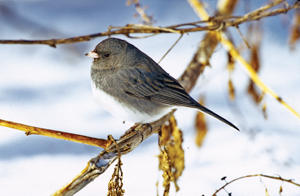 Juncos and Snow Just Seem to Go Together
Juncos and Snow Just Seem to Go Together
Is it just fate or an ancient rhythm of life that often brings the first snowfall and the first Junco sighting at the same time each year?
Whatever the explanation, Dark-eyed Juncos are often called “Snowbirds,” and many people believe their return from their northern breeding grounds does indeed foretell the return of winter’s cold and snowy weather. Even its white belly plumage and slate-colored back reminds one of a winter scene with its “leaden sky above, and snow below.”
During the winter, Juncos are sighted at more feeding areas across North America than any other bird. Over 80 percent of the participants in Project Feeder Watch reported seeing Juncos at their feeders. A 1995 research study estimated the North American population of Dark-eyed Juncos at approximately 630 million.
Juncos spend the entire winter in flocks averaging in size from six to thirty or more birds.
They prefer to roost in evergreens at night, but will also use tall grasses and brush piles. They return to the same roost location repeatedly, sharing it with other flock mates, but they do not huddle together.
Like many other members of the Sparrow family, they are primarily ground feeders and are drawn to the millet and mixed seeds around the base of your feeders or ground-tray feeders.
Now is a great time to attract juncos. Visit the store soon and provide the expert advice and products needed to help attract these cold-weather visitors.

